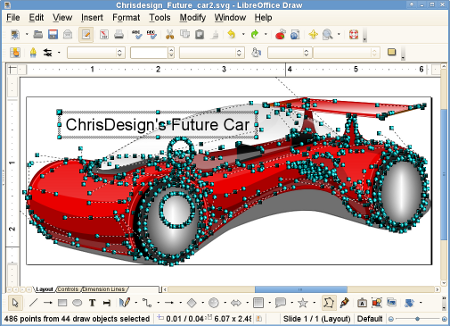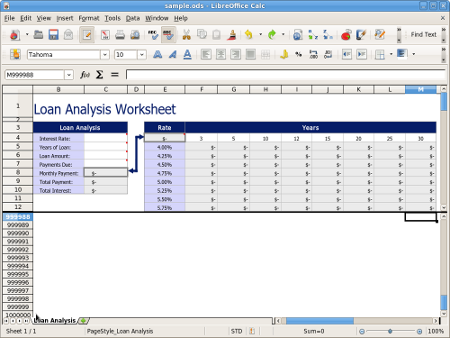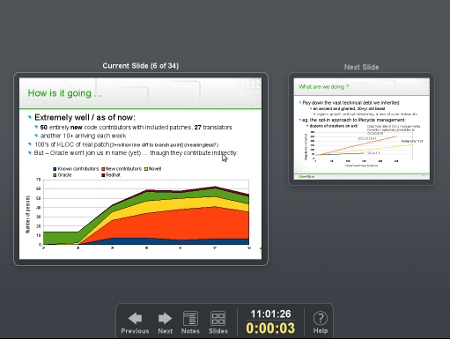LibreOffice sees light, free of Oracle and OpenOffice
Jan 25, 2011 — by LinuxDevices Staff — from the LinuxDevices Archive — 4 viewsThe Document Foundation launched the first stable version of its open source LibreOffice productivity suite, following a breakaway from OpenOffice.org and Oracle's control. Due for inclusion in Ubuntu 11.04, among other Linux distros, LibreOffice 3.3 is a bit leaner than OpenOffice, and aims to get more so in the future to support mobile devices, says the group.
The Document Foundation launched LibreOffice 3.3 on Jan. 25, a mere five days after announcing a release candidate. This is the first stable release of the open source office suite since its breakaway from Oracle's OpenOffice.org project in September.
Concerned about Oracle's plans for OpenOffice after the Sun acquisition, about a third of OpenOffice developers formed the Document Foundation in September, then forked the software into their own version. The Document Foundation has a number of big names backing it, including Red Hat, Google, Novell, and Canonical.

LibreOffice 3.3 Draw, showing ability to import SVG files
(Click to enlarge)
The LibreOffice development community has been concentrating on the 3.3 release as well as cleaning up the codebase inherited from OpenOffice, said Italo Vignoli, a founding member of the Document Foundation. "It was necessary to prove that we are able to have our own software and development process for the future," Vignoli told eWEEK.
Leaning toward a leaner mobile future
The number of developers working on LibreOffice has nearly quintupled since September, according to Vignoli. The community has also been discussing the "evolution" of office suites, said Vignoli. "We feel that office suites are 20 years old, and what is happening around the user is really going in different directions from where the office suites were when Windows was born," he said.
Vignoli pointed to the proliferation of alternative platforms now available, including tablets, netbooks, and smartphones, and said that office suites were not designed for them. "Our developers were telling us that the source code was a little bit too old to match the vision for the future," said Vignoli.
While LibreOffice 3.3 is still not yet ready to support mobile platforms - "we cannot change software in a few days" — the cleaning has started, resulting in leaner code compared to its OpenOffice 3.3 counterpart, Vignoli said. While LibreOffice 3.3 has new and original features, Vignoli said the focus was on cleaning up the code and integrating new infrastructure to make the project sustainable and independent of Oracle.
"For too many years, the focus has been on adding features, but the normal user is using 10 to 20 percent of the features," Vignoli said. Saying it was "probably useless to continue to go to war on the features," Vignoli added that the community will concentrate on flexibility to fit user needs, which are changing all the time.

Need a million rows in your spreadsheet? LibreOffice 3.3 Calc says go for it.
(Click to enlarge)
New imports and extensions, streamlined Calc
LibreOffice 3.3 also has some new and original features of its own, such as the ability to import and work with SVG and Microsoft Works files (see image at top). In addition, it provides a easier way to format and number text blocks in Writer, and offers improved sheet and cell management in Calc, says the Document Foundation. The developers also bundled new extensions, such as PDF import, a slide-show presenter console (see image below), and an improved report builder.

LibreOffice and its new slide-show presenter console
(Click to enlarge)
Despite getting the first release out, the team doesn't have a lot of time to relax. Vignoli said the first enhancements, including critical bug fixes, new icons, and localization improvements, will be available in February. A release candidate of version 3.3.1 is expected by Feb. 7, followed by a final release on Feb. 14, he said.
A second set of enhancements, which will include critical bug fixes and more localization improvements, is expected on March 7 as a release candidate, with the final version due on March 14. After that, development will be settling into a regular release schedule, with a beta for version 3.4, complete with new features, tentatively expected in late March, and a final release in May.
Vignoli added that the differences between LibreOffice and OpenOffice will be more pronounced with LibreOffice 3.4.
Availability
The stable version of LibreOffice 3.3 is now available for free download at the Document Foundation's LibreOffice page.
Fahmida Rashid is a writer for our sister publication eWEEK.
This article was originally published on LinuxDevices.com and has been donated to the open source community by QuinStreet Inc. Please visit LinuxToday.com for up-to-date news and articles about Linux and open source.